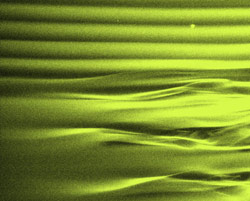Rough Skin is Good

The erratic, swirling fluid motion known as turbulence increases wind resistance, and airplane manufacturers go to great lengths to eliminate rough surfaces that promote it. Now, however, researchers have observed that carefully chosen roughness can actually suppress turbulence, at least in the lab, as they report in the 17 February PRL. If they can repeat the effect in the real world, it could save billions of dollars in fuel costs each year.
Engineers distinguish two types of drag force on an object moving through a fluid like air. A blunt object, such as a baseball, feels mostly “pressure drag,” which arises from the difference between the oncoming air in front and the “sheltered” region in the wake just behind it. In contrast, a long, streamlined object, such as an airplane wing, feels mostly “friction drag” as its surfaces slide past slower moving air.
When a wing is moving slowly, air flows smoothly around it like honey around a spoon. At higher speeds, however, the flow becomes turbulent. Small disturbances are amplified as the air moves along the wing, growing into turbulence some distance behind the leading edge. Turbulence can make the friction drag ten times larger. Now Jens Fransson, of KTH, the Royal Institute of Technology in Stockholm, and his colleagues have shown how to push the transition to turbulence further back on the wing–or past the wing altogether.
Instead of dragging a wing through the air, the researchers used a wind tunnel to send air streaming across a several-meter-wide rectangular plate and injected smoke to reveal the air flow. They added a small pressure oscillation to trigger turbulence. As they expected, the oscillation grew as the air moved along the plate, until the flow became turbulent about a meter behind the leading edge.
The team then attached a set of pill-shaped disks flat against the plate, in a row parallel to the leading edge but 8 centimeters behind it. The disks only stuck up 1.4 millimeters above the surface but still caused ribbons of spiraling flow in the air downstream. That flow smoothed out formerly turbulent air more than a meter away.
The design was based on previous theoretical predictions that such a swirling flow would suppress the growth of the pressure oscillations into turbulence. According to the theory, the flow boosts the so-called viscous effects of the air, which inhibit the oscillations the way honey would slow any oscillation, such as a submerged pendulum.
“Since the mid 1950’s roughness elements have been known to trigger transition [to turbulence],” Fransson says. But “we put in roughness elements, and we show that we can delay transition. This is very new.” He suggests that a similar strategy might suppress chaotic behavior in situations ranging from lasers to fusion plasmas.
“What is really slick about it is it’s a passive strategy,” in contrast to complex schemes that “actively” eliminate turbulence after it has developed, says Edward White of Case Western Reserve University in Cleveland, Ohio. But he cautions that the clean experimental result may not capture what happens in the real world. George Karniadakis of Brown University agrees that the new result is a “good contribution,” but he suspects that the disks will cause extra pressure drag that may overwhelm any reductions. Fransson says the disks only increase pressure drag by 3.5% but that the team hasn’t yet measured the net drag.
–Don Monroe
Don Monroe is a freelance science writer in Murray Hill, New Jersey.


